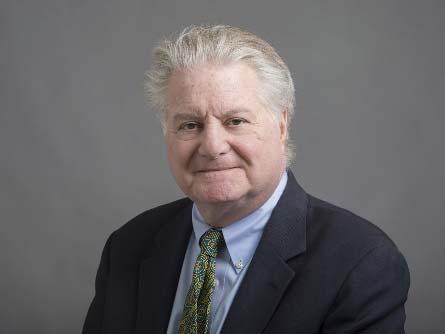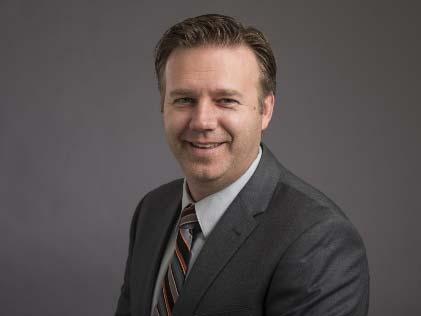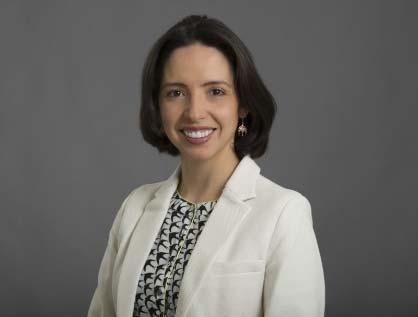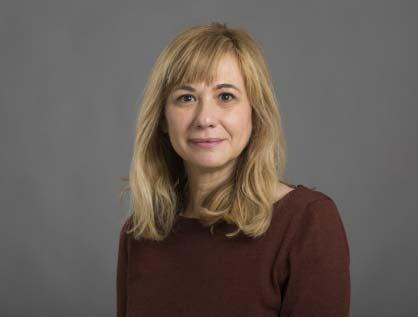

Improving Patients’ Lives Through Epilepsy Care & Research
Accurate diagnoses are vital for patients to receive the best possible care. At the RUSH Epilepsy Center, donor support has empowered our specialists to get diagnosis and care down to a science to help patients experience their best quality of life.
RUSH’s epilepsy specialists compassionately diagnose and treat all cases — from the most routine to the most complex. With help from our robust community of supporters, our team leads the field in applying leading-edge research to patient care — a process known as bench-to-bedside or translational research. Imaging capabilities at the RUSH Multimodal Neuroimaging Laboratory are essential to helping our experts make exact diagnoses and pinpoint, precisely, where seizures originate in the brain. Philanthropy has dramatically advanced RUSH’s neuroimaging and research capabilities by helping physicians and scientists collect, analyze and accurately assess more images to advance care and generate new knowledge of epilepsy for the entire field.
With donor support, RUSH leads the way in advancing neuroimaging for epilepsy through radiomics research, providing services that are unavailable elsewhere and making treatmentadvancing discoveries that improve people’s lives. Radiomics is a rapidly growing area of medical science that uses mathematical algorithms to analyze data available from high-powered patient images and enhance clinical decision-making.
In 2023, RUSH acquired a 3T MRI scanner — the health system’s most advanced — which has the strongest magnet field strength for greater accuracy in imaging. The RUSH Epilepsy Center uses this scanner for all outpatient clinical screening. Donor support helps RUSH epilepsy experts collect neuroimaging data for promising research that advances efforts to identify biomarkers for specific types of epilepsy and specific demographics. With patient consent, the lab uses a robust repository of patient imaging, specimens and data to assist with research and advance patient care.
The RUSH Epilepsy Center’s dedicated team, directed by Michael C. Smith, MD, professor and division chief of the Section of Epilepsy and Clinical Neurophysiology, is devoted to helping each patient receive the care that works best for them and their individual circumstances. With your help, the team investigates promising hypotheses that translate into new and better care approaches.
On the following pages, we are proud to highlight the exciting progress made by our talented team of epilepsy physicians and researchers whose efforts are propelled by donor support.
In the words of Dr. Smith,

“Donors fuel progress in academic medicine.” Thank you for making these advancements possible. You are making a difference in the lives of our patients and people with epilepsy far beyond RUSH.
Getting a Clearer Picture With Radiomics
Epilepsy care is grounded in neuroscience, and studies in RUSH’s labs are having direct results on patient care. With donor support, RUSH is leading some of the field’s most innovative research to advance diagnostic capabilities and treatments. Advancements in research directly translate into improved care possibilities for patients with epilepsy.
Earlier this year, a man in his 40s sought care from the RUSH Epilepsy Center for medically refractory epilepsy that began when he was a baby. This condition occurs when medications do not control seizures well or at all. RUSH specialists analyzed an electroencephalogram, or EEG, scan of the man’s brain, which revealed an active area on the le ft side, but the exact location was unclear.
To specify the location, the team performed what is called a subtracted ictal single photon emission computed tomography (SPECT) coregistered to MRI, or SISCOM. For this procedure, a nuclear medicine technologist injected the patient with a radioactive SPECT tracer during a seizure and again while the patient was not having a seizure. The images were then compared to each other to reveal the area of increased activity during a seizure. The image was overlayed on an MRI scan for even better spatial resolution.
The SISCOM image revealed an area of hyperperfusion, or increased blood flow, in the mesial portion of the superior temporal gyrus/insular cortex. This is shown in red in the adjacent image. Next, the team needed to pinpoint the cause.
Building on a strong base of machine learning research, the RUSH Epilepsy Center recently introduced a new software program to its lab called CAT12, which runs on the programming platform MATLAB. The program assesses structural differences in one patient’s brain activity compared to a large control group. MATLAB was purchased with donor support.
Using this software, the team identified a significant structural difference in the patient’s brain in an area just adjacent to the SISCOM hyperperfusion pictured to the right. (Please note the images are flipped in this software compared to the SISCOM image above.)
Due to the location of the lesion, the patient was not a candidate for surgical resection. As an alternative, the team successfully implanted a responsive neurostimulation device in the abnormal area. This device detects oncoming seizures and delivers electrical current to prevent, stop or shorten the seizures. Since this procedure, the patient’s seizures have dramatically improved.


The RUSH Epilepsy Center helped another patient achieve seizure-free outcomes using a different type of modeling.
The center employs a specialized piece of high-density EEG equipment and software that uses additional scalp sensors in a head cap to deliver better EEG coverage. The software then uses mathematical modeling to localize the patient’s EEG abnormalities onto an MRI scan in 3D, shown to the right.

The green areas indicate EEG abnormalities in relation to a lesion identified by an MRI scan in red.
With this tool, physicians localized and removed the entire extent of the abnormality for a patient in their 30s who had medically intractable epilepsy. The patient has now been seizurefree for four years.
This equipment and software is no longer supported by its original warranty, so the center plans to renew its license and technical support using philanthropic funds. Donor support will ensure this tool can help more patients live better lives.
These success stories are just two examples of the phenomenal outcomes made possible by donor support of epilepsy research and care at RUSH. Our standard and specialized imaging capabilities in our clinic and lab, which combine advanced imaging techniques with precise analyses driven by highpowered computer algorithms, draw more patients than any other imaging lab in the Chicago area. With the right tools and information, our experts can achieve life-changing breakthroughs in care.
Discovering New Radiomics Markers for Temporal Lobe Epilepsy
Together, Travis Stoub, PhD, associate professor, and Rebecca O’Dwyer, MD, assistant professor, both in the Department of Neurological Sciences, lead the epilepsy center’s innovative radiomics research efforts.
Over the last year, the lab uncovered new radiomics markers for temporal lobe epilepsy and featured this work during a poster presentation at the American Epilepsy Society’s December 2022 meeting. Researchers, with help from fellows and undergraduate trainees, found that radiomics can identify subtle MRI abnormalities in patients with medically intractable, non-lesional temporal lobe epilepsy. This discovery is likely to improve future diagnostic capabilities, enabling physicians to identify candidates who would benefit from curative resection surgery.
The discovery builds upon the lab’s strong foundational work that has proven radiomics’ ability to differentiate patients with epilepsy from neurotypical controls with high sensitivity and specificity.


Advancing Research and Sharing Results With the Scientific Community
In the past year, the RUSH Epilepsy Center has continued to advance epilepsy research that is benefiting the field locally and internationally. The following recent progress has been made possible with donor support:
Researching epilepsy in older adults: Dr. O’Dwyer and her team continued to enroll patients and analyze data in their study examining seizures in older adults — the fastest-growing demographic of people with epilepsy. Researchers submitted two abstracts related to this work: The first involves errors in a cognitive dysfunction test that asks older adults to draw a clock, and the second is an analysis of discrepancies in quality of life between older and younger people with epilepsy.
Seeking a biomarker of SUDEP: Under the direction of Adrianna Bermeo-Ovalle, MD, associate professor in the Department of Neurological Sciences, researchers are seeking a biomarker of sudden unexpected death in epilepsy, or SUDEP, in hopes of one day finding a preventative measure or therapeutic for this tragic complication.

Donor support enables Dr. Bermeo-Ovalle and her team to collaborate with other epilepsy experts locally and globally, while also recruiting and training future specialists. With patient consent, data from the RUSH Epilepsy Center is sent to a shared repository that is part of an international collaborative study to identify potential SUDEP biomarkers. Additionally, Dr. Bermeo-Ovalle recently began hosting a podcast called “Epilepsy Currents” with the American Epilepsy Society and published EEG guidelines in Spanish as part of a collaboration with the American Clinical Neurophysiology Society.
Sharing findings with the scientific community: RUSH researchers submitted an article regarding the use of a convolutional neural network (a machine-assisted support tool) to pinpoint the area of seizure onset in patients with epilepsy to the journal Neurology; an article about setting up EEG source imaging to the journal Clinical Neurophysiology; and an article about the structural connectivity of the piriform cortex (an area of the brain involved in processing smells) to the journal Neurosurgery.
Bolstering our expert team: Philanthropic funding recently enabled the lab to hire, part-time, an engineer and a machine learning statistician to help with complex analyses of the immense data that radiomics generates.
“We are now more efficient in our processes, and we are able to build complex models to analyze our radiomics data,” Dr. Stoub said. “None of this is possible without philanthropic support.”
Progressing clinical trials: RUSH continues to enroll eligible participants in the STATUS Trial, a multicenter clinical trial examining a promising investigational therapy for superrefractory status epilepticus. We are also enrolling participants in the Epilepsy Neuronal Changes Study, examining brain tissue removed during surgeries to better understand epilepsy’s effects.
Promoting Collaboration and Teaching the Next Generation
The RUSH Epilepsy Center serves as a rich training ground for students with an interest in caring for epilepsy patients as well as those interested in careers in engineering, math, computer science and statistics. By participating in research, students can learn directly from epilepsy experts and obtain hands-on experience with projects aimed at improving patients’ lives. The lab offers the following educational opportunities:
Undergraduate research positions: Open to students from universities local to Chicago and around the country, these positions enable students to collect and analyze data and process MRI brain images for epilepsy research. Many of the lab’s undergraduate trainees have gone on to medical or graduate school where they have continued work in research.
Graduate and doctoral research positions: RUSH University students may pursue two-year master’s or five-year doctoral research projects at the lab. These students develop and carry out projects themselves under the direction of Drs. Stoub and O’Dwyer and their respective research committees. Additionally, the lab welcomes RUSH medical students and residents to learn research techniques and lead research projects.
The RUSH University Epilepsy Fellowship: This one-year fellowship provides advanced training in the comprehensive management of care for epilepsy and related disorders. It offers one to two positions each year to candidates who have completed an accredited neurology residency program. Upon completion, fellows are eligible to take the American Board of Psychiatry and Neurology’s epilepsy subspecialty certification examination.

The fellowship is directed by Antoaneta J. Balabanov, MD, associate professor in the Department of Neurological Sciences and medical director of the RUSH Epilepsy Center. Dr. Balabanov is passionate about training the next generation of physicians. Under her supervision, fellows learn about clinical care and engage in research and imaging studies.
Well-trusted for their experience and expertise, RUSH’s epilepsy specialists lend their skills to colleagues advancing imaging studies in other specialties and departments. This spirit of partnership and collaboration has resulted in other sections receiving internal and external funding.
For example, the lab collaborates with Joan O'Keefe, PhD, PT, associate professor in the Department of Anatomy & Cell Biology, on her research focused on Fragile X tremor and ataxia syndrome. The lab helps with MRI processing and protocols, using the health system’s new 3T MR I research scanner. Dr. O’Keefe recently received funding from the U.S. Department of Defense for her project titled “Neural Underpinnings of the Relationship Between Cognitive and Gait Dysfunction in Fragile X-Associated Tremor/Ataxia Syndrome (FXTAS).” Dr. Stoub and his team are listed as collaborators on the grant.
“Because of our resources, we have become a department hub for imaging research,” Dr. Stoub said.
Help RUSH Specialists Improve People’s Lives
RUSH’s epilepsy physicians and scientists are using advancements made possible by donor support in the clinic each day to improve care — and life — for people with epilepsy. Support propels their ongoing work to further refine the field’s knowledge of epilepsy and improve treatments to continue to help patients lead full, healthy lives.
Your support will enable our experts to build on their exciting progress and create new possibilities in epilepsy diagnosis and care. In the words of Dr. Stoub, “Philanthropy opens the door of discovery and directly changes the lives of our patients forever.”

To make a gift or learn more about supporting epilepsy care and research at RUSH, contact:
Brigid Mullen
Executive Director of Development (312) 942-4460 brigid_t_mullen@rush.edu
